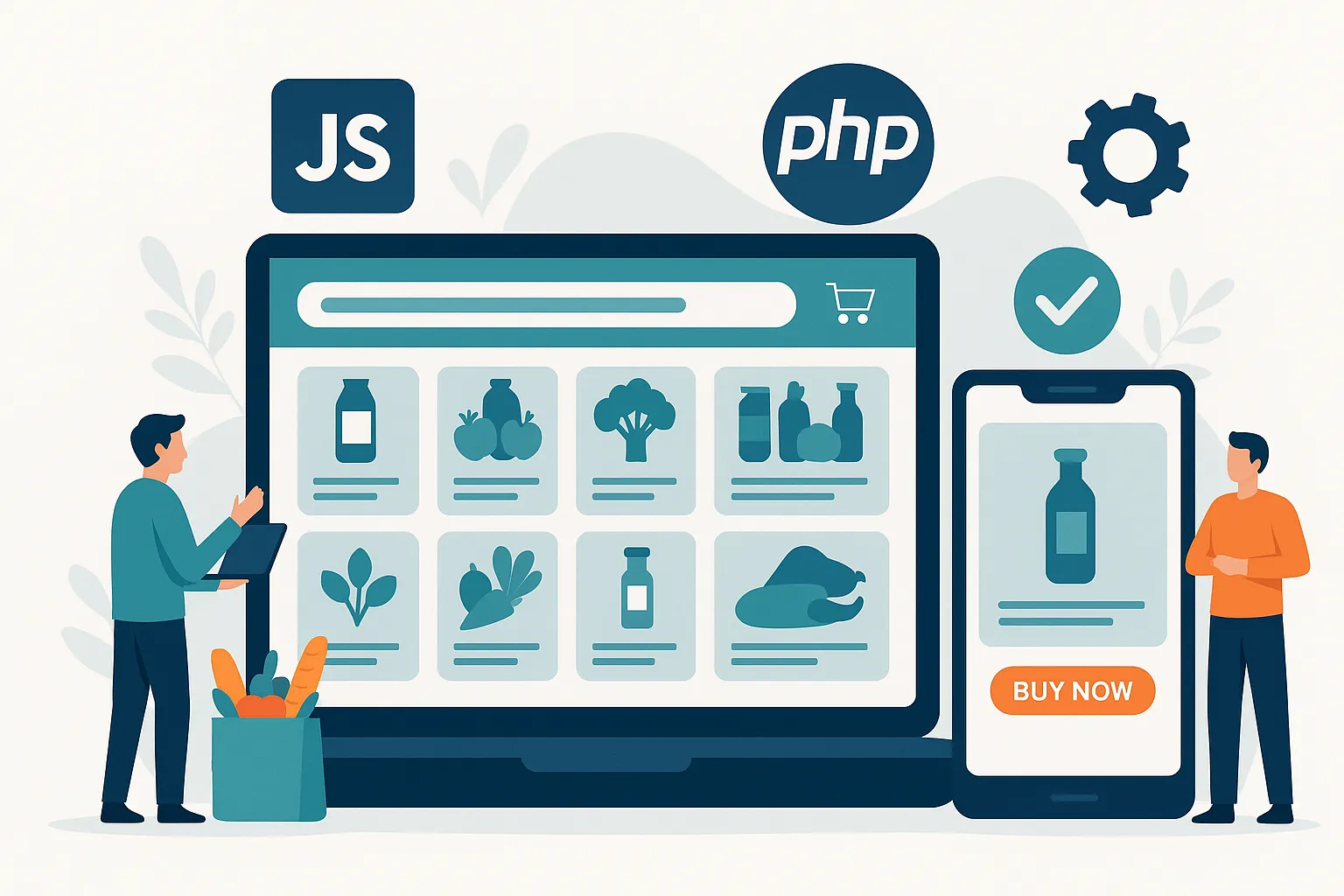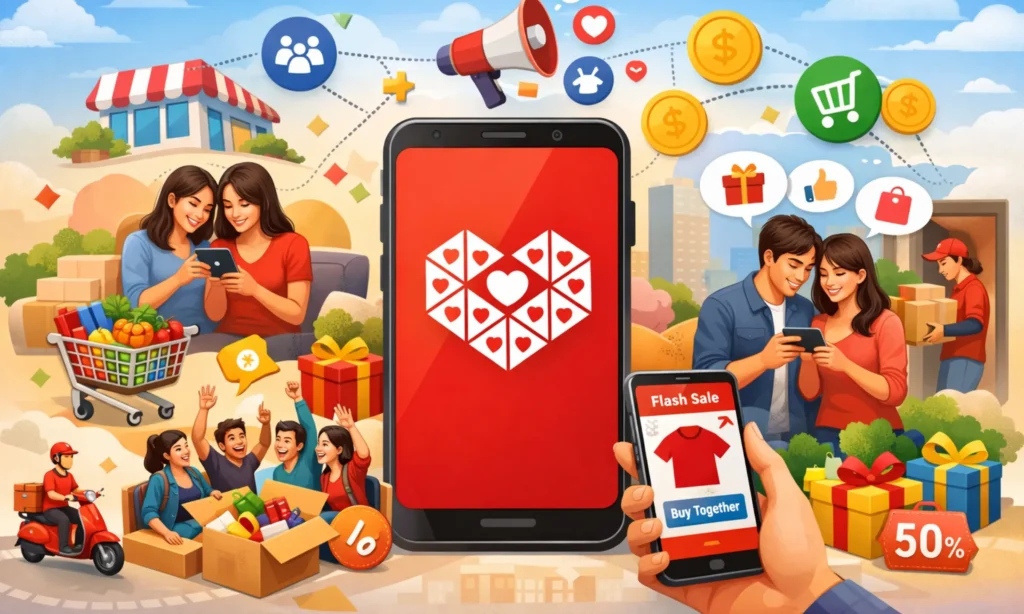Building an app like AmazonFresh was one of the most rewarding and technically challenging projects I’ve taken on as a full-stack developer. If you’re a startup founder or agency eyeing the online grocery delivery space, you’re on the right track—because in 2025, convenience sells. Consumers want groceries delivered fast, in one place, and with reliability they can count on.
AmazonFresh is a classic example of how tech can completely change the grocery experience. From real-time inventory and user location tracking to scheduled delivery and dynamic pricing—there’s a lot going on under the hood. In this guide, I’ll walk you through how I approached building an AmazonFresh-like app from scratch using both JavaScript (Node.js + React) and PHP (Laravel). You’ll get the real developer’s perspective—how I thought through each decision, what tools I used, how I structured the backend, and the differences between going the Node vs PHP route.
Choosing the Right Tech Stack: JavaScript vs PHP for AmazonFresh Clone Development
When you’re building something like AmazonFresh, tech stack selection isn’t just about preference — it’s about what’s scalable, efficient, and developer-friendly for your current and future goals. I explored two parallel stacks for this project: a full JavaScript-based setup (Node.js + React) and a classic PHP approach (Laravel or CodeIgniter). Here’s how I broke it down:
JavaScript Stack: Node.js + React
When I Use This:
I lean toward the Node.js + React stack when the product roadmap involves high interactivity, frequent real-time operations (e.g., tracking, instant cart updates), and scalability. It’s also a great fit when working with modern dev teams that prefer API-first architecture and non-blocking asynchronous behavior.
Backend: Node.js with Express
Frontend: React + Redux (for predictable state)
Package Manager: npm or Yarn
Realtime: Socket.io (for delivery status, cart sync, etc.)
Authentication: JWT
Payment Integration: Stripe SDK / Razorpay API
Deployment: PM2 + Nginx + Docker
Pros:
- Asynchronous by design — ideal for live order updates
- Shared language (JavaScript) across frontend and backend
- Massive npm ecosystem
- React’s component reusability made frontend fast to build
Cons:
- Needs careful memory management in long sessions
- API management can grow messy without strict architecture
PHP Stack: Laravel or CodeIgniter
When I Use This:
PHP still shines when I need to get a reliable MVP out quickly or when the client’s infrastructure already supports it (cPanel, Apache, MySQL). Laravel is my go-to if I need modern PHP structure, while CodeIgniter works well for lightweight builds.
Backend: Laravel 10+ (or CI4 if going lean)
Frontend: Blade templates + jQuery/Alpine.js
Realtime (optional): Pusher or Laravel Echo
Authentication: Laravel Sanctum / built-in Auth
Payment Integration: Laravel Cashier, Razorpay SDK
Deployment: Apache + Shared/VPS Hosting + Docker (optional)
Pros:
- Fast development using Artisan CLI & built-in features
- Mature ORM (Eloquent) for database access
- Strong security defaults out of the box
- Easy to onboard new devs
Cons:
- Not asynchronous by default
- Requires more configuration for real-time features
My Take:
If you’re building a high-volume, dynamic delivery platform and plan to scale with mobile apps and microservices, go with the JavaScript stack. But if you want speed to market and proven stability—PHP with Laravel is a great choice.
Reda More : Best AmazonFresh Clone Scripts in 2025: Features & Pricing Compared
Database Design: Structuring for Scalability & Speed
Whether you’re building on Node.js or PHP, your database is the heartbeat of your AmazonFresh clone. It handles thousands of products, real-time orders, delivery zones, and user data. So I designed mine to be flexible, nested where needed, and built for performance.
My Stack Choices:
- JavaScript Stack: MongoDB (NoSQL)
- PHP Stack: MySQL (Relational)
Let’s look at the structure I used in both cases.
MongoDB Schema (Node.js)
MongoDB’s document-based format is ideal for a fast-moving grocery app. I used embedded documents where appropriate (like cart items inside user data) and normalized where updates were frequent.
Sample Collections:
// Product
{
_id: ObjectId,
name: "Organic Apples",
category: "Fruits",
price: 2.99,
stock: 150,
image_url: "...",
isAvailable: true,
tags: ["organic", "seasonal"]
}
// User
{
_id: ObjectId,
name: "John Doe",
email: "[email protected]",
cart: [
{
product_id: ObjectId,
quantity: 2
}
],
addresses: [
{
label: "Home",
street: "...",
city: "...",
zip: "..."
}
]
}
// Order
{
_id: ObjectId,
user_id: ObjectId,
status: "pending",
payment_status: "paid",
total: 42.50,
items: [...],
delivery_slot: {
date: "2025-06-21",
time: "10:00 - 12:00"
}
}Why MongoDB?
- Flexible schema for changing product specs
- Great for handling nested cart and delivery data
- Better performance for read-heavy workloads like search filters
MySQL Schema (Laravel / CodeIgniter)
If you’re going PHP, MySQL is usually the natural choice. I kept my schema normalized to avoid duplication and maintain referential integrity.
Sample Tables:
CREATE TABLE users (
id INT PRIMARY KEY AUTO_INCREMENT,
name VARCHAR(255),
email VARCHAR(255) UNIQUE,
password VARCHAR(255)
);
CREATE TABLE products (
id INT PRIMARY KEY AUTO_INCREMENT,
name VARCHAR(255),
category_id INT,
price DECIMAL(10,2),
stock INT,
image_url TEXT,
is_available BOOLEAN
);
CREATE TABLE orders (
id INT PRIMARY KEY AUTO_INCREMENT,
user_id INT,
status ENUM('pending', 'delivered', 'cancelled'),
total DECIMAL(10,2),
delivery_slot DATETIME,
FOREIGN KEY (user_id) REFERENCES users(id)
);
CREATE TABLE cart_items (
id INT PRIMARY KEY AUTO_INCREMENT,
user_id INT,
product_id INT,
quantity INT,
FOREIGN KEY (user_id) REFERENCES users(id),
FOREIGN KEY (product_id) REFERENCES products(id)
);
Why MySQL?
- Strong ACID compliance—great for transaction integrity
- Works seamlessly with Laravel Eloquent
- Easier analytics and reporting via SQL queries
Bonus: Indexing & Optimization
Regardless of DB, I always:
- Indexed
category,isAvailable, andpricefor fast filters - Used pagination for product listings
- Batched writes for bulk inventory updates
- Cached popular product queries using Redis
Read More : Amazonfresh App Marketing Strategy: How to Win Big in the Online Grocery Race
Key Modules & Features: Building the Core Functionality
An AmazonFresh clone isn’t just a product listing page with a cart. It’s a full-fledged operations engine — with real-time inventory, user roles, delivery logistics, and admin oversight. I broke it down into modular components to make the system easy to maintain and scale.
Below are the key modules I implemented, along with how I handled them in both JavaScript (Node.js + React) and PHP (Laravel/CI) stacks.
1. Product Catalog & Category Filters
Purpose: Display available items by category, price, and tags (e.g., “organic”, “on sale”).
- Node.js: Created
/productsAPI with query parameters.
// Sample API Endpoint
GET /api/products?category=vegetables&tag=organic&sort=price_ascUsed Mongoose’s .find() with chained filters and limit/skip for pagination.
Laravel: Used Eloquent query scopes for filtering.
Product::available()->filterByCategory('vegetables')->withTags(['organic'])->orderBy('price')->paginate(20);On the frontend (React/Blade), I cached filters locally and applied optimistic UI updates for performance.
2. Smart Cart System
Purpose: Allow real-time cart updates, with quantity changes, pricing logic, and stock validation.
- Node.js: Maintained cart in MongoDB inside the user object. Used Redux on the frontend to update cart instantly and pushed updates with Socket.io.
- Laravel: Stored cart in a
cart_itemstable. Used sessions for guest carts andAuthmiddleware for registered users.
Both stacks included:
- Subtotal calculations
- Auto-remove if stock changes
- Cart persistence between sessions
3. Order Management System
Purpose: Users place orders, choose delivery time, and track them.
- Node.js: Orders handled via
/ordersPOST route. I created a background worker (using Bull.js) to queue confirmation emails and auto-assign delivery time slots. - Laravel: Used
OrderController@store()to handle submissions and queued background jobs with Laravel Horizon.
Both stacks supported:
- Order history views
- Delivery ETA tracking
- Cancellation window and refund logic
4. Search & Suggestion Engine
Purpose: Speed up product discovery and increase conversion.
- Node.js: Integrated with ElasticSearch for fuzzy keyword matching.
- PHP: Used Laravel Scout with Algolia for full-text search.
Both allowed:
- Typo tolerance
- Autocomplete suggestions
- Synonym support (e.g., “aubergine” = “eggplant”)
5. Admin Dashboard
Purpose: Allow managers to control product listings, inventory, users, and reports.
- React Admin Panel (JS Stack):
- Protected with role-based routes using React Router
- API-driven charts using Chart.js + D3
- CRUD via RESTful endpoints
- Laravel Nova / Blade Admin (PHP Stack):
- Laravel Nova gave me instant scaffolding
- Custom reports added using Nova Cards
- Role-based access handled via Laravel Gates & Policies
Admin features:
- Add/edit/delete products
- View real-time orders
- Assign delivery partners
- Set category-wide discounts
6. Delivery & Slot Booking System
Purpose: Let users choose time slots and locations for delivery.
- Created a
slotstable/collection with:- Date
- Time Range
- Max Orders
- Current Bookings
- On checkout, users picked from available slots. I added validation to lock slots using DB-level transactions in Laravel, and atomic counters in MongoDB.
Each of these modules was designed to be API-first, making them adaptable for both web and mobile apps. I kept the structure modular so we could enable/disable features (like scheduled delivery) based on the business model.
Read More : AmazonFresh App Features List: What Makes It Click with Modern Shoppers?
Data Handling: Third-Party APIs vs Manual Listings
For a grocery delivery app like AmazonFresh, data comes from two key sources: third-party APIs (for large inventories or real-time prices) and manual listings (for localized control). I made sure our system could do both — so it’s flexible for startups that want to scale with either automation or hands-on management
Option 1: Third-Party API Integration
When you want to pull in product data dynamically — especially for broad regions or partner supermarkets — third-party APIs can save you time. I worked with mock grocery APIs and even explored integrations like Spoonacular, Walmart Open API, and some private retailer endpoints.
Node.js Approach:
- Used
axiosto fetch product listings. - Scheduled syncs using node-cron to pull every 6 hours.
- Stored data in MongoDB after transforming into our schema.
const fetchExternalData = async () => {
const res = await axios.get('https://api.example.com/products');
const items = res.data.map(formatItem);
await Product.insertMany(items);
};
Laravel Approach:
- Used Laravel’s
Http::get()via theIlluminate\Support\Facades\Httpfacade. - Created Artisan commands to fetch and sync products on a schedule via Laravel Scheduler.
$data = Http::get('https://api.example.com/products')->json();
foreach ($data as $item) {
Product::updateOrCreate(['external_id' => $item['id']], [...]);
}Challenges:
- Mapping external fields to internal schema
- Dealing with rate limits & authentication
- Ensuring freshness of inventory & price
Option 2: Manual Product Uploads via Admin Panel
Some founders want to manage their own inventory—especially if they run dark stores or local chains. So I made sure the admin panel supported full CRUD for products.
Node.js (React Admin):
- Created form components using React Hook Form.
- Handled image uploads to Cloudinary or AWS S3.
- Backend validation via Express and Mongo schema.
Laravel (Nova / Blade Admin):
- Built Nova resources for Product with validation rules.
- Used Laravel’s built-in file upload and image manipulation.
- Applied form requests for cleaner logic.
Key fields supported:
- Product name, image, price, stock
- Tags (organic, imported, etc.)
- Category (mapped to filters)
- Delivery zones & availability flags
Hybrid Mode: Best of Both Worlds
In production, many apps want hybrid flexibility. So I added a flag to distinguish between api-synced and manually-added products. This way:
- API data can refresh automatically
- Manual entries stay untouched
- Admins can override API products if needed
This setup also made it easier to run experiments — e.g., show a different product set to a specific region or user group.
API Integration: Crafting the Backbone of the AmazonFresh Clone
If the frontend is the storefront, the API is the warehouse. It connects your UI, database, third-party services, and admin operations. I designed a RESTful API layer for both the Node.js and Laravel versions, with clean separation, consistent response formats, and proper auth control.
Node.js + Express API (JavaScript Stack)
I kept everything modular using Express Router, structured with controllers and middlewares.
Sample Route: Get Products
// routes/products.js
router.get('/', async (req, res) => {
const { category, tag, sort } = req.query;
const filters = buildProductFilters(category, tag);
const products = await Product.find(filters).sort(sort).limit(20);
res.json({ success: true, data: products });
});Auth Middleware (JWT):
const verifyToken = (req, res, next) => {
const token = req.headers.authorization?.split(' ')[1];
if (!token) return res.status(401).json({ error: 'Unauthorized' });
try {
const decoded = jwt.verify(token, process.env.JWT_SECRET);
req.user = decoded;
next();
} catch {
res.status(403).json({ error: 'Invalid token' });
}
};
Order Creation Endpoint:
router.post('/orders', verifyToken, async (req, res) => {
const { items, slot } = req.body;
const total = calculateTotal(items);
const order = await Order.create({
userId: req.user.id,
items,
slot,
total,
status: 'pending'
});
res.json({ success: true, order });
});
Laravel API (PHP Stack)
Laravel made it easier to structure routes and controllers using its resource system.
Sample ProductController:
public function index(Request $request)
{
$products = Product::when($request->category, fn($q) =>
$q->where('category_id', $request->category))
->when($request->tag, fn($q) =>
$q->whereJsonContains('tags', $request->tag))
->orderBy('price')
->paginate(20);
return response()->json(['success' => true, 'data' => $products]);
}
API Routes:
Route::middleware('auth:sanctum')->group(function () {
Route::post('/orders', [OrderController::class, 'store']);
Route::get('/profile', [UserController::class, 'me']);
});
OrderController (store):
public function store(Request $request)
{
$order = Order::create([
'user_id' => auth()->id(),
'items' => json_encode($request->items),
'slot' => $request->slot,
'total' => calculateTotal($request->items),
'status' => 'pending'
]);
return response()->json(['success' => true, 'order' => $order]);
}
Shared Practices Across Both Stacks
- Consistent Responses: Always
{ success, data, error }structure. - Validation:
- Node.js: Used Joi for schema validation
- Laravel: Used FormRequest and built-in rules
- Rate Limiting:
- Node.js:
express-rate-limit - Laravel:
ThrottleRequestsmiddleware
- Node.js:
- Versioning:
/api/v1/...for future-proofing - Security: Sanitized inputs and enforced CSRF where relevant
Explore our complete cost guide to building an AmazonFresh-style grocery delivery app, with breakdowns by feature, platform, and location.
Frontend & UI Structure: Clean, Fast, and Mobile-First
For a grocery delivery app like AmazonFresh, the frontend isn’t just about aesthetics — it’s where conversion happens. If users can’t find, filter, or order products in seconds, they’ll leave. So I focused on creating a fast, responsive, and intuitive interface that works seamlessly on mobile and desktop.
Here’s how I built the frontend in both JavaScript (React) and PHP (Blade/Laravel).
React Frontend (JavaScript Stack)
React gave me complete flexibility in building a dynamic, reusable UI. I structured the app using atomic components, Redux for state management, and React Router for client-side navigation.
Page Structure:
- Homepage: Banners, category highlights, featured products
- Product Listing: Grid with filters and sorting
- Product Detail: Nutritional info, availability, quantity selector
- Cart: Real-time total, stock checks, and discount codes
- Checkout: Address form, delivery slot picker, payment gateway
- User Dashboard: Order history, saved addresses, logout
Component Breakdown:
ProductCard: Handles individual item displayCartDrawer: Slide-in cart experience (especially for mobile)DeliverySlotPicker: Modal with date/time logicSearchBar: Autocomplete powered by debounced API calls
Styling Tools:
- TailwindCSS for utility-first styling
- Framer Motion for lightweight animations
- React Icons for visual cues
Mobile Responsiveness:
- Used responsive grid systems (
grid-cols-2,md:grid-cols-4) - Mobile-first approach: collapsible filters, sticky cart button
- Dynamic resizing with
useMediaQueryto toggle components
Speed Optimizations:
- Lazy loading for product images
- Code splitting with React.lazy & Suspense
- Client-side caching for repeated filters
Blade Frontend (Laravel Stack
For the PHP version, I used Laravel Blade templating with a focus on simplicity and speed. The goal: give backend teams a way to quickly update UI without diving into JavaScript-heavy codebases.
Layout Structure:
layouts.app: Master layout with header/footerpartials: Included components like navbar, filters, product card@yieldand@sectionused to inject content dynamically
Styling Tools:
- Bootstrap 5 for layout & responsiveness
- Blade components (
<x-product-card>) for reusability - jQuery (optional) for UI toggles like cart preview or filter collapse
Mobile Responsiveness:
- Bootstrap grid with
col-6 col-md-3for responsive products - Toggleable sidebars for filters on smaller screens
- One-page checkout layout with vertical stepper
Speed Optimizations:
- Server-side rendering = faster initial load
- Cached Blade views
- Product image thumbnails auto-generated via Intervention Image
Shared UX Highlights
- Sticky Cart CTA on mobile for better conversion
- Back-to-top button on long product pages
- Progress bar during checkout (React: NProgress, Laravel: Alpine.js)
- Accessibility: Labeled buttons, keyboard navigation support
Whether you go with React or Blade, make sure the flow feels predictable and fast. No one wants to scroll endlessly for onions or wrestle with a slow cart on mobile.
Authentication & Payments: Securing Users and Enabling Smooth Transactions
A grocery delivery app like AmazonFresh handles sensitive user data and real money — so authentication and payments need to be airtight. My goal was to make login seamless, account management intuitive, and checkout secure and frictionless. Here’s how I implemented it across both stacks.
Authentication System
Node.js + JWT (JavaScript Stack)
I used JSON Web Tokens (JWT) for stateless, secure authentication across React and Node.
Key Endpoints:
POST /auth/registerPOST /auth/loginGET /auth/profile(protected route)
How It Works:
- On login, I generate a JWT with user ID and expiry.
- Stored token in HTTP-only cookies or localStorage (with precautions).
- Middleware (
verifyToken) guards private routes.
const token = jwt.sign({ id: user._id }, process.env.JWT_SECRET, { expiresIn: '7d' });
res.cookie('token', token, { httpOnly: true });Frontend: Used React Context + Protected Routes for auth-based rendering.
Laravel Auth (PHP Stack)
Laravel made it easy to get secure login and registration running quickly.
Options Used:
- Laravel Sanctum (for SPA APIs with token-based auth)
- Built-in Auth scaffolding for Blade projects
Login Process:
if (Auth::attempt($credentials)) {
$token = $user->createToken('auth_token')->plainTextToken;
return response()->json(['token' => $token]);
}Route Protection:
Route::middleware('auth:sanctum')->group(function () {
Route::get('/orders', [OrderController::class, 'index']);
});
Frontend: Blade templates rendered conditionally using @auth and @guest.
Payment Gateway Integration
Stripe & Razorpay Support
Depending on the region, I supported both Stripe (global) and Razorpay (India-centric).
Stripe Integration (Node.js)
- Used
stripenpm package - Created a
paymentIntenton the server - Handled UI with Stripe Elements on React
const intent = await stripe.paymentIntents.create({
amount: totalAmount,
currency: 'usd',
metadata: { userId: req.user.id }
});- Client-side handled card entry and token confirmation.
Razorpay Integration (Laravel)
- Used the official Razorpay PHP SDK
- Created orders on Razorpay and returned the order ID to frontend
- Captured payment via webhook (to mark order as paid)
$api = new Api($key, $secret);
$order = $api->order->create([
'receipt' => 'order_rcptid_11',
'amount' => 50000, // in paise
'currency' => 'INR'
]);Security Measures Implemented
- CSRF Tokens: Enabled in Laravel forms and Axios requests
- Rate Limiting: Login and payment endpoints limited with middleware
- Input Validation: All forms validated on frontend and backend
- HTTPS-only Cookies: Ensured tokens weren’t accessible via JS
- Webhook Signature Checks: Verified payment events from Stripe/Razorpay
Whether you use JWT or Laravel Sanctum, Stripe or Razorpay, the goal is the same: give users confidence that their data and money are safe — while keeping friction to a minimum during checkout.
Read More : How to Build a Food Delivery Platform Like Amazon Fresh: From Design to Launch
Testing & Deployment: Ensuring Quality and Launch-Readiness
After building all the core features, the real test begins — can the app hold up in production? I’ve seen beautifully coded grocery apps crumble under unexpected load or fail because of tiny bugs in the checkout flow. So I built out a proper testing suite, containerized everything with Docker, and used CI/CD pipelines to push updates safely.
Testing Strategy
JavaScript Stack (Node.js + React)
Backend (Node.js):
- Testing Framework: Jest + Supertest
- Test Coverage: Auth, product filtering, order creation, payment intents
- Sample Test:
describe("POST /orders", () => {
it("should create a new order for logged-in user", async () => {
const res = await request(app)
.post("/api/orders")
.set("Authorization", `Bearer ${token}`)
.send({ items: [...], slot: "2025-06-20 10:00" });
expect(res.status).toBe(200);
expect(res.body.order).toHaveProperty("status", "pending");
});
});Frontend (React):
- Testing Library: React Testing Library
- Focus: Component rendering, state changes, cart flow
- Tools: Mock Service Worker (MSW) for API mocks
PHP Stack (Laravel / CI)
Backend (Laravel):
- Framework: PHPUnit
- What I Tested:
- Controllers (orders, auth, products)
- Validation logic
- Business rules (e.g., delivery slot locking)
public function test_user_can_create_order()
{
$user = User::factory()->create();
$response = $this->actingAs($user)->post('/api/orders', [...]);
$response->assertStatus(200);
$this->assertDatabaseHas('orders', ['user_id' => $user->id]);
}
Blade UI Tests:
- Used Laravel Dusk for end-to-end browser automation
- Simulated full flows: register → add to cart → checkout
Dockerization
I used Docker for both local development and production parity. This let me run services like the app, DB, and cache in isolated environments.
Key Services:
- Node.js or PHP-FPM container
- MongoDB or MySQL
- Redis
- Nginx reverse proxy
Sample docker-compose.yml:
services:
app:
build: .
volumes: ['./:/app']
ports: ['3000:3000']
environment:
- NODE_ENV=production
mongo:
image: mongo
ports: ['27017:27017']
nginx:
image: nginx
volumes: ['./nginx.conf:/etc/nginx/nginx.conf']
ports: ['80:80']CI/CD Pipelines
JavaScript (Node.js + React):
- Used GitHub Actions for testing + building Docker images
- Triggered deployments to DigitalOcean via
doctlor to AWS ECS
jobs:
build:
runs-on: ubuntu-latest
steps:
- uses: actions/checkout@v2
- run: npm install && npm test
- run: docker build -t amazonfresh-clone .PHP (Laravel):
- Used GitLab CI/CD and Envoyer for zero-downtime deployments
.envfiles and secrets handled via Vault / CI secrets
Runtime & Process Management
- Node.js: Used
PM2with ecosystem configs for auto-restart, log monitoring, and zero-downtime reloads. - Laravel: Deployed via Supervisor and managed queues with
php artisan queue:work.
Monitoring & Logs
- Logs shipped to LogDNA or Papertrail
- Alerting set up for:
- Payment failures
- API errors (rate > threshold)
- Slow DB queries
Pro Tips & Real-World Learnings: What I Wish I Knew Before Building
Building an AmazonFresh-style grocery delivery app is more complex than it looks on paper. You’re not just coding — you’re building a logistics engine, a dynamic pricing tool, a real-time stock monitor, and a user experience that has to work under pressure (like during a sale or weekend spike). Here’s the raw, hard-earned advice from my build experience.
1. Start with Mobile in Mind
Most grocery users are mobile-first. They browse and checkout during commutes, lunch breaks, or late nights. That means:
- Optimize for touch — buttons, filters, and modals should feel native
- Minimize input friction — autofill, saved addresses, slot memory
- Progressive loading — don’t wait for 1000 items to load before showing the UI
Tailwind and CSS Grid made this easier on React. On Blade, I used Bootstrap’s d-flex, sticky-top, and responsive modals for clean mobile UX.
2. Watch Your Inventory Logic Like a Hawk
Inventory syncing is the #1 pain point in grocery apps.
- Build atomic update logic — one function to manage stock changes per order, cart, and admin updates.
- Queue updates when syncing with external APIs to prevent race conditions.
- Use DB-level constraints or optimistic locking to avoid overbooking.
In Laravel, I used DB transactions. In MongoDB, I implemented atomic $inc operations with retries on failure.
3. Caching is Your Best Friend (Until It Isn’t)
I aggressively cached:
- Product lists (by tag, category)
- Home page highlights
- Delivery slots (availability count)
- Cart previews
Tools Used:
- Node.js: Redis with
ioredisand TTLs - Laravel: Laravel Cache with Redis driver + tags
But caching gets tricky when stock is limited or changes often — so I set up cache invalidation triggers on:
- New order placed
- Admin updates product stock
- Scheduled API sync
4. Plan for Failed Payments & Retries
You’ll get failed Stripe intents or half-completed Razorpay orders. Make sure you:
- Log failed attempts with user context
- Allow users to retry payment from “Pending Orders”
- Send email reminders with one-click retry links
I used Stripe webhooks to trigger fallbacks and Razorpay’s order.status API to re-check after delay.
5. Don’t Overbuild the Admin Panel Too Early
You don’t need analytics, refunds, delivery partner assignment, and 8 kinds of reports on day one.
Start with:
- CRUD for products, users, and orders
- Basic delivery slot manager
- Toggle availability / promotions
Only after launch did I add features like:
- Product bulk import (CSV)
- Promo codes and auto-discounts
- Delivery zone heatmaps
Final Reminder:
Build it like you’re scaling from day one — even if you’re not. Whether you’re using Node.js or Laravel, keeping your logic clean, separating concerns, and setting up sensible limits will help you survive the first 1,000 orders — and scale to 100,000.
Final Thoughts: Go Custom When Needed, Clone When It Counts
After building this AmazonFresh-style app from scratch — both in Node.js and Laravel — here’s my honest take: you don’t need to reinvent the wheel unless your wheel really has to fly.
I get it — as a founder, you want flexibility, control, and uniqueness. But chasing “custom from day one” can delay your launch by months and drain your resources. I’ve been there. Debugging inventory race conditions, building payment retries, and testing delivery slot logic isn’t glamorous — it’s necessary, but time-consuming.
That’s why platforms like Miracuves’ AmazonFresh Clone exist. They offer the exact blueprint I’ve laid out — modular backend, clean frontend, third-party API flexibility, manual inventory control, admin panels, and multi-payment support — ready to launch.
If I were advising a founder today? Start with a proven clone, launch fast, test your market, and customize as you grow.
You get all the benefits of a battle-tested architecture, plus the room to tweak your frontend, optimize user flows, or integrate deeper logistics tools when you’re ready. Whether you’re scaling regionally or building for a niche (organic-only, ultra-fast delivery, etc.), the Miracuves clone sets you up with the right foundation.
If you’re serious about launching a grocery delivery app in 2025, don’t waste months on base-layer functionality. Get to market fast — and build smart from there.
Check out the Miracuves AmazonFresh Clone — launch-ready, scalable, and developer-approved.
FAQs: Founder Questions Answered
1. How customizable is the AmazonFresh clone script from Miracuves?
Very. The Miracuves AmazonFresh clone is modular by design — whether you’re using Node.js or Laravel. You can customize everything from product filters and cart logic to delivery slot mechanics and admin roles. Want to add multilingual support, geo-fencing, or dynamic pricing? Totally doable.
2. Can I choose between Node.js and PHP, or is it pre-decided?
You can choose. Miracuves supports both full JavaScript (Node.js + React) and PHP (Laravel) stacks. We guide you based on your team’s comfort level, hosting environment, and expected scalability needs. For ultra-fast APIs and real-time features, Node is a great pick. For quicker MVPs and shared hosting setups, Laravel works beautifully.
3. What kind of delivery logistics can this system support?
The platform supports:
Scheduled delivery slots
Real-time delivery tracking (with optional partner API integrations)
Delivery zone configuration via admin
Max-order thresholds per slot
We’ve designed it to fit both in-house fleets and third-party delivery networks.
4. Can I start with manual product uploads and later integrate APIs?
Absolutely. The system is built for hybrid workflows. You can start with manual uploads via the admin dashboard and later plug in third-party APIs for automated inventory updates. The data structure supports syncing, overrides, and tagging to separate internal vs external items.
5. How secure is the payment system?
We follow industry-standard practices:
Stripe and Razorpay integration with secure token handling
Webhook validation for payment events
HTTPS-only, CSRF-protected forms
JWT or Sanctum-based authentication
Logs and alerts for anomalies
Security’s baked into the workflow, not tacked on later.
Related Articles









